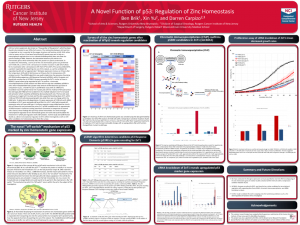Brik, Ben: A Novel Function of p53: Regulation of Zinc Homeostasis
Title: A Novel Function of p53: Regulation of Zinc Homeostasis
Name: Ben Brik
Major: Genetics
School affiliation: Honors College,School of Arts and Sciences
Programs: Aresty – Research or Conference Funding Recipient, Honors College Capstone
Other contributors: Xin Yu, Darren Carpizo
Abstract: p53 is a tumor suppressor, also known as “the guardian of the genome”, which has been found to be mutated in over 50% of all cancers. The relationship between p53 and zinc is important as zinc is essential to the proper structure and function of p53. With either a lack or excess of zinc, it has been found that p53 cannot carry out its role as a transcriptional regulator due to zinc-induced misfolding which does not allow site-specific binding of DNA. However, the interaction between p53 and the zinc homeostatic genes which ultimately affect the protein are poorly understood. To elucidate this relationship, a survey of all the zinc homeostatic genes was performed with V138 cells; a cell line with a temperature-sensitive mutation in p53 which allows for its reactivation after a temperature shift from 37°C to 32°C. The survey yielded ZnT1, a protein responsible for exporting zinc out of the cytosol, as a prime candidate for regulation by p53 with an approximate 7-fold gene expression increase at 4 hours after the temperature shift and 12-fold increase at 8 hours after the temperature shift relative to actin. The p53MH algorithm was used to determine the presence of putative p53 DNA-binding sequences, p53 Response Elements (p53REs), within the genes and found high-scoring sites in SLC30A1, the gene encoding for ZnT1, similar to those in MDM2, a gene known to be regulated by p53. To confirm, a chromatin immunoprecipitation (ChIP) analysis with the top two candidates p53REs in ZnT1 revealed both had a greater total amount of DNA bound to p53 using p21 for comparison. A luciferase reporter assay yielded positive results that p53 bound to and activated the prime ZnT1 p53RE candidate with an approximate 10-fold increase in luciferase activity post-Nutlin treatment in comparison to control cells. Overall, these findings that p53 may control intracellular zinc levels through transcriptional regulation of zinc homeostatic genes are novel and could elucidate the mechanism in which p53 regulates itself and functions. Further study and confirmation of p53 as a direct transcriptional regulator of ZnT1 in-vivo will be investigated as well as with other candidate zinc homeostatic genes derived from the survey.
